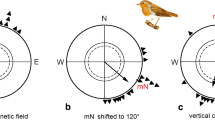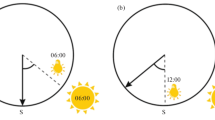Abstract
This analysis is based on 103 releases with 6-h clock-shifted pigeons of various ages and experiences. Resetting the internal clock normally leads to a significant change in initial orientation; however, in half of the cases, the induced deflections are significantly smaller than predicted by the sun compass hypothesis. The relative size of the deflections decreases with increasing age and experience (Fig. 3). Only young pigeons with limited experience respond as expected, while old birds show deflections which are, on the average, only slightly more than half of the predicted size, except at extremely familiar sites (Table 2). There is no difference between fast and slow shifts (Fig. 4). It is not possible to clearly specify under what circumstances smaller deflections occur; previous clock-shifts (Fig. 5), familiarity with the release site (Table 4) and duration of the shifting procedure (Table 5) do not seem to be the reasons. Clock-shifting also tends to decrease the vector lengths and has a marked effect on homing performance (Table 7). Nevertheless, considerable numbers of clock-shifted birds return on the day of release before their internal clock has begun to be reset back to normal. The general role of the sun compass in bird orientation is considered and theoretical implications of our findings are discussed in view of the ‘map and compass’-model and the possibility that an alternative, non-time-compensating compass is used in parallel with the sun compass.
Similar content being viewed by others
References
Alexander J, Keeton WT (1974) Clock-shifting effect on initial orientation of pigeons. Auk 91:370–374
Batschelet E (1981) Circular statistics in biology. Academic Press, London New York
Benvenuti S, Fiaschi V, Fiore L, Papi F (1973) Homing performances of inexperienced and directionally trained pigeons subjected to olfactory nerve section. J Comp Physiol 83:81–92
Foa A, Albonetti E (1980) Does familiarity with the release site influence the initial orientation of homing pigeons? Experiments with clock-shifted birds. Z Tierpsychol 54:327–338
Frisch K von (1950) Die Sonne als Kompaß im Leben der Bienen. Experientia 6:210–221
Frisch K von (1965) Tanzsprache und Orientierung der Bienen. Springer, Berlin Heidelberg New York
Füller E, Kowalski U, Wiltschko R (1983) Orientation of homing pigeons: Compass orientation vs piloting by familiar landmarks. J Comp Physiol 153:55–58
Graue LC (1963) The effect of phase shifts in the day-night cycle on pigeon homing at distances of less than one mile. Ohio J Sci 63:214–217
Hartwick RF, Foa A, Papi F (1977) The effect of olfactory deprivation by nasal tubes upon homing behaviour in pigeons. Behav Ecol Sociobiol 2:81–89
Keeton WT (1969) Orientation by pigeons: Is the sun necessary? Science 165:922–928
Keeton WT (1973) Release-site bias as a possible guide to the “map” component in pigeon homing. J Comp Physiol 86:1–16
Keeton WT (1974) The orientational and navigational basis of homing in birds. In: Lehrman DS, Hinde RA, Shaw E (eds) Advances in the study of behavior, vol 5. Academic Press, New York San Francisco London, pp 47–132
Keeton WT (1979) Avian orientation and navigation: a brief overview. Br Birds 72:451–470
Kramer G (1950) Weitere Analyse der Faktoren, welche die Zugaktivität des gekäfigten Vogels orientieren. Naturwissenschaften 37:377–378
Kramer G (1953) Wird die Sonnenhöhe bei der Heimfindeorientierung verwendet? J Ornithol 94:201–219
Kramer G (1957) Experiments on bird orientation and their interpretation. Ibis 99:196–227
Kramer G (1959) Recent experiments on bird orientation. Ibis 101:399–416
Kumpfmüller R, Wiltschko R (1993) Orientierung von Brieftauben: Lernen und Wiederlernen des Sonnenkompaß. Verh Dtsch Zool Ges 86, 259
Matthews GVT (1953) Sun navigation in homing pigeons. J Exp Biol 30:243–267
Neuss M, Wallraff HG (1988) Orientation of displaced homing pigeons with shifted circadian clocks: Prediction vs observation. Naturwissenschaften 75:363–365
Quire DB (1982) Infrasound: a potential cue for homing pigeons. In: Papi F, Wallraff HG (eds) Avian Navigation. Springer, Berlin Heidelberg New York, pp 373–376
Schmidt-Koenig K (1958a) Der Einfluß experimentell veränderter Zeiteinschätzung auf das Heimfindevermögen von Brieftauben. Naturwissenschaften 45:47
Schmidt-Koenig K (1958b) Experimentelle Einflußnahme auf die 24-Stundenperiodik bei Brieftauben und deren Auswirkungen unter besonderer Berücksichtigung des Heimfindevermögens. Z Tierpsychol 15:301–331
Schmidt-Koenig K (1961) Die Sonne als Kompaß im Heim-Orientierungssystem der Brieftauben. Z Tierpsychol 18:221–244
Schmidt-Koenig K (1965a) Current problems in bird orientation. In: Lehrman DS, Hinde RA, Shaw E (eds) Advances in the study of behavior. Academic Press, New York London, pp 217–278
Schmidt-Koenig K (1965b) Über den zeitlichen Ablauf der Anfangsorientierung bei Brieftauben. Verh Dtsch Zool Ges 28:107–111
Schmidt-Koenig K (1972) New experiments on the effect of clock shifts on homing in pigeons. In: Galler SR, Schmidt-Koenig K, Jacobs GJ, Belleville RE (eds) Animal orientaion and navigation (NASA SP-262). US Government Print Office, Washington DC, pp 275–282
Schmidt-Koenig K (1979) Avian orientation and navigation. Academic Press, London New York San Francisco
Schmidt-Koenig K, Keeton WT (1977) Sun compass utilization by pigeons wearing frosted contact lenses. Auk 94:143–145
Schmidt-Koenig K, Ganzhorn JU, Ranvaud R (1991a) The sun compass. In: Berthold P (ed) Orientation in birds. Birkhäuser, Basel, pp 1–15
Schmidt-Koenig K, Ranvaud R, Ganzhorn JU, Gasparotto OC (1991b) Retardation of homing pigeons'ephemerides? Naturwissenschaften 78, 330–331
Schöps M (1991) Der Einfluß von Infraschall auf das Orientierungssystem von Brieftauben. Verh Dtsch Zool Ges 84:361–362
Wallraff HG (1966) Über die Anfangsorientierung von Brieftauben unter geschlossener Wolkendecke. J Ornithol 107:326–336
Wallraff HG (1974) Das Navigationssystem der Vögel. Ein theoretischer Beitrag zur Analyse ungeklärter Orientierungsleistungen. Schriftenreihe: Kybernetik. Oldenbourg, München Wien
Wiltschko R (1980) Die Sonnenorientierung der Vögel. I. Die Rolle der Sonne im Orientierungssystem und die Funktionsweise des Sonnenkompaß. J Ornithol 121:121–143
Wiltschko R (1981) Die Sonnenorientierung der Vögel. II. Entwicklung des Sonnenkompaß und sein Stellenwert im Orientierungssystem. J Ornithol 122:1–22
Wiltschko R (1983) The ontogeny of orientation in young pigeons. Comp Biochem Physiol 76A:701–708
Wiltschko R (1992) Das Verhalten verfrachteter Vögel. Vogelwarte 36:249–310
Wiltschko R (1993) Pigeon homing: Release site biases and their interpretation. In: Royal Institute of Navigation (ed) Orientation and navigation — birds, humans and other animals. Royal Institute of Navigation, Oxford, Paper 15
Wiltschko R, Wiltschko W (1980) The process of learning sun compass orientation in young homing pigeons. Naturwissenschaften 67:512–514
Wiltschko R, Wiltschko W (1981) The development of sun compass orientation in young homing pigeons. Behav Ecol Sociobiol 9:135–141
Wiltschko R, Wiltschko W (1985) Pigeon homing: change in navigational strategy during ontogeny. Anim Behav 33:583–590
Wiltschko W (1993) Magnetic compass orientation in birds and other animals. In: Royal Institute of Navigation (ed) Orientation and navigation — birds, humans and other animals. Royal Institute of Navigation, Oxford, Paper 12
Wiltschko W, Balda RP (1989) Sun compass orientation in seed-caching scrub jays (Aphelocoma coerulescens). J Comp Physiol 164:717–721
Wiltschko W, Wiltschko R (1988) Magnetic orientation in birds. Curr Ornithol 5:67–121
Wiltschko W, Wiltschko R, Keeton WT (1984) Effect of a “permanent” clock-shift on the orientation of experienced homing pigeons. Behav Ecol Sociobiol 15:263–272
Wiltschko W, Beason RC, Wiltschko R (1990) Sensory basis of orientation: concluding remarks. In: Bell BD, Cossee RO, Flux JEC, Heather BD, Hitchmough RA, Robertson CJR, Williams MS (eds) Acta XX Congr Internat Ornithol. Ornithological Congress Trust Board, Christchurch, New Zealand, pp 1845–1850
Author information
Authors and Affiliations
Additional information
Communicated by Robin F.A. Moritz
Rights and permissions
About this article
Cite this article
Wiltschko, R., Kumpfmüller, R., Muth, R. et al. Pigeon homing: the effect of a clock-shift is often smaller than predicted. Behav Ecol Sociobiol 35, 63–73 (1994). https://doi.org/10.1007/BF00167061
Received:
Accepted:
Issue Date:
DOI: https://doi.org/10.1007/BF00167061




